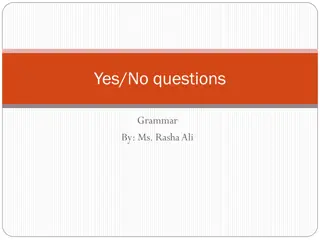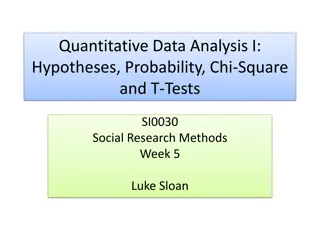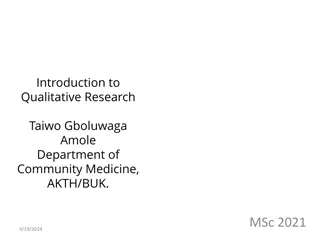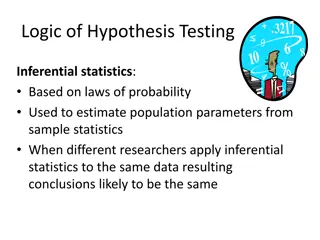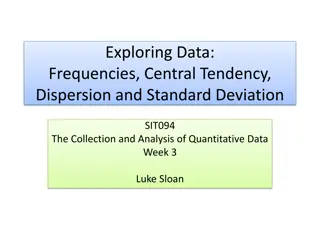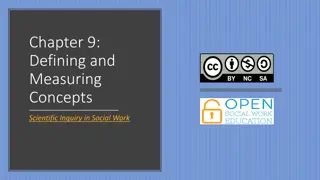
Constructing Quantitative Research Questions and Hypotheses
Learn how to formulate quantitative research questions and hypotheses in the context of quantitative research analysis. Understand the process of identifying a research problem, pinpointing variables of interest, and selecting the appropriate research design. Get insights into creating effective questions to drive your research forward.
Download Presentation

Please find below an Image/Link to download the presentation.
The content on the website is provided AS IS for your information and personal use only. It may not be sold, licensed, or shared on other websites without obtaining consent from the author. If you encounter any issues during the download, it is possible that the publisher has removed the file from their server.
You are allowed to download the files provided on this website for personal or commercial use, subject to the condition that they are used lawfully. All files are the property of their respective owners.
The content on the website is provided AS IS for your information and personal use only. It may not be sold, licensed, or shared on other websites without obtaining consent from the author.
E N D
Presentation Transcript
HOW TO CONSTRUCT QUANTITATIVE RESEARCH QUESTIONS AND HYPOTHESES Justin D Souza Quantitative Analyst Statistics Solutions
Topic Development Prospectus or Concept Papers Introduction Chapter Literature Review Chapter (identifying articles) Methodology Chapter (Quantitative/Qualitative). IRB forms Data entry templates Survey Monkey upload Results Chapter (Quantitative/Qualitative) Discussion Chapter Powerpoints for Defense Journal Publications Assistance Statistics Solutions Provides For a free 30-minute consultation, schedule a meeting with our production manager: https://app.hubspot.com/meetings/jeanine/dissertation- consultation
Quantitative research involves collection of data in a numerical form which can be put into categories, or in rank order, or measured in units of measurement. Quantitative Research vs Qualitative research questions involve study of concepts in their natural settings, attempting to make sense of, or interpret, phenomena in terms of the meanings people bring to them. Qualitative Research
Before developing the research questions, you first need to identify a research problem. Identifying a Research Problem What is the gap in the literature? A review of the literature should be one of the first steps in identifying the research objective.
After identifying the research problem and gap in the literature, create a list of all the key variables of interest. Pinpoint Variables of Interest Are these variables numerically measurable? Do you need to use a self-report survey or can you find archival/secondary data to measure these variables?
Identify what type of research design you are going to use. Common quantitative research designs: Descriptive/Exploratory Correlational Common Quantitative Research Designs Experimental, Quasi-Experimental, Causal Comparative Longitudinal
A descriptive/exploratory research question is not attempting to prove or disprove hypotheses necessarily. It is trying to describe trends in the sample. A sample research question will look like: RQ1: What are the trends in job satisfaction among teaching faculty? RQ2: What is the predominant leadership style used among managers? Descriptive or Exploratory Design Questions like these are usually addressed through examination of descriptive statistics such as frequencies/percentages of survey responses, or means/standard deviations of variables.
Correlational research is an umbrella concept that encompasses both correlational (two-way associations) and regression analysis (predictive). For correlational analysis, it is not required to have independent and dependent variables. You just need two variables of interest. A correlational research question will have the following format: RQ: Is there a significant relationship/association between X and Y? Sample RQ1: Is there a significant relationship between age and self-efficacy? Sample RQ2: Is there a significant association between education and job position? Correlational Design The most common correlational analyses are: Pearson correlations tests association between two continuous variables. Spearman correlations tests association between two variables, when at least one variable is an ordinal measure (multiple choice item). Chi-square tests of independence tests association between two categorical (nominal) variables.
Sample RQ1: Is there a significant relationship between age and self-efficacy? H0: There is not a significant relationship between age and self-efficacy. HA: There is a significant relationship between age and self-efficacy. Correlational Design (Continued) - Hypotheses Sample RQ2: Is there a significant relationship between education and job position? H0: There is not a significant relationship between education and job position. HA: There is a significant relationship between education and job position.
A correlational design following a regression approach examines how independent variable(s) predict a dependent variable. In regression analysis, the independent variable is often called the predictor and the dependent variable is called the criterion variable. A regression-based question will have the following format: RQ: Is there a significant predictive relationship between X and Y? Sample RQ1: Is there a significant predictive relationship between age and self-efficacy? Sample RQ2: Do emotional exhaustion, depersonalization, and personal accomplishment significantly predict academic performance? Sample RQ3: Is there a significant predictive relationship between GPA and passing/failing an exam? Correlational Design Regression Approach The most common regression-based analyses are: (Multiple) Linear regression tests predictive relationship between independent variable(s) and continuous (interval/ratio) dependent variable. Binary logistic regression tests predictive relationship between independent variable(s) and dichotomous (two groups) dependent variable. Multinomial logistic regression tests predictive relationship between independent variable(s) and categorical (more than 2 groups) dependent variable. Ordinal logistic regression tests predictive relationship between independent variable(s) and ordinal dependent variable.
Sample RQ1: Is there a significant predictive relationship between age and self-efficacy? H10: There is not a significant predictive relationship between age and self-efficacy. H1A: There is a significant predictive relationship between age and self-efficacy. Correlational Design Regression Approach - Hypotheses Sample RQ2: Is there a significant predictive relationship between GPA and passing/failing an exam? H10: There is not a significant predictive relationship between GPA and passing/failing an exam. H1A: There is a significant predictive relationship between GPA and passing/failing an exam.
For experimental, quasi-experimental, and causal-comparative designs, the goal is typically to assess for differences in variables between groups. You need an independent variable (group factor) and a dependent variable (the value you are trying to assess for differences in). Experimental, Quasi- Experimental, Causal- Comparative Designs
An experimental-based question will have the following format: RQ: Is there a significant difference in Y between the groups of X? Sample RQ1: Is there a significant difference in job satisfaction between treatment and control groups? Sample RQ2: Is there a significant difference in self-efficacy based on race? Sample RQ3: Are there significant differences in emotional exhaustion, depersonalization, and personal accomplishment between race? Sample RQ4: Are there significant differences in emotional exhaustion, depersonalization, and personal accomplishment between race, while controlling for job satisfaction? Experimental, Quasi- Experimental, Causal- Comparative Designs (Continued) Sample Questions and Analyses The most common analyses for these types of designs are: Independent sample t-test tests for differences in continuous dependent variable between two groups. ANOVA tests for differences in continuous dependent variable between three or more groups. MANOVA tests for differences in multiple continuous dependent variables between three or more groups. ANCOVA/MANCOVA tests for differences in continuous dependent variable(s) between three or more groups, while controlling for another factor.
Sample RQ1: Is there a significant difference in job satisfaction between treatment and control groups? H10: There is not a significant difference in job satisfaction between treatment and control groups. H1A: There is a significant difference in job satisfaction between treatment and control groups. Sample RQ2: Are there significant differences in emotional exhaustion, depersonalization, and personal accomplishment between race? H01: There is not a significant difference in emotional exhaustion between race. HA1: There is a significant difference in emotional exhaustion between race. H02: There is not a significant difference in depersonalization between race. HA2: There is a significant difference in depersonalization between race. H03: There is not a significant difference in personal accomplishment between race. HA3: There is a significant difference in personal accomplishment between race. Experimental, Quasi- Experimental, Causal- Comparative Designs (Continued) Hypotheses
A longitudinal design typically assesses for differences in a value over time. There can be an overlap with experimental designs. Such as conducting an intervention (treatment vs control) and running a pretest and posttest, simultaneously. You need a dependent variable if only assessing for differences over time. If factoring in a grouping factor (such as treatment/control), then you also need an independent variable (grouping factor). Longitudinal Design
A longitudinal-based question will have the following format: RQ: Is there a significant difference in Y between 1 and 2? Sample RQ1: Is there a significant difference in knowledge between pretest and posttest of educational intervention? Sample RQ2: Is there a significant difference in knowledge between baseline, post-test, and follow-up? Sample RQ2: Is there a significant difference in knowledge over time and between groups? Longitudinal Design (Continued) Sample Questions and Analyses The most common longitudinal (with potential experimental component) analyses are: Dependent (paired) sample t-test tests for differences in continuous dependent variable between two points in time. Repeated Measures ANOVA tests for differences in continuous dependent variable over three or more points in time. Mixed Model ANOVA tests for differences in continuous dependent variable over time and between groups.
Sample RQ1: Is there a significant difference in knowledge between baseline, post-test, and follow-up? H0: There is not a significant difference in knowledge between baseline, post-test, and follow-up. HA: There is a significant difference in knowledge between baseline, post-test, and follow-up. Sample RQ2: Is there a significant difference in knowledge over time and between groups? H01: There is not a significant difference in knowledge over time. HA1: There is a significant difference in knowledge over time. H02: There is not a significant difference in knowledge between groups. HA2: There is a significant difference in knowledge between groups. H03: There is not a significant difference in knowledge over time and between groups. (interaction effect) HA3: There is a significant difference in knowledge over time and between groups. (interaction effect) Longitudinal Design (Continued) - Hypotheses
Identify problem statement and gap in the literature. Select quantitative versus qualitative approach. Identify variables of interest level of measurement for each variable (nominal, ordinal, or interval). Determine whether data can be collected through survey or archival/secondary data. Select research design (exploratory, correlational, experimental/quasi-experimental/causal comparative, longitudinal) Develop research questions and hypotheses following appropriate research design. Determine statistical analyses used to address questions and hypotheses. Summary
Topic Development Prospectus or Concept Papers Introduction Chapter Literature Review Chapter (identifying articles) Methodology Chapter (Quantitative/Qualitative) IRB forms Data entry templates Survey Monkey upload Results Chapter (Quantitative/Qualitative) Discussion Chapter Powerpoints for Defense Journal Publications Thank You! For a free 30-minute consultation, schedule a meeting with our production manager: https://app.hubspot.com/meetings/jeanine/dissertation- consultation




